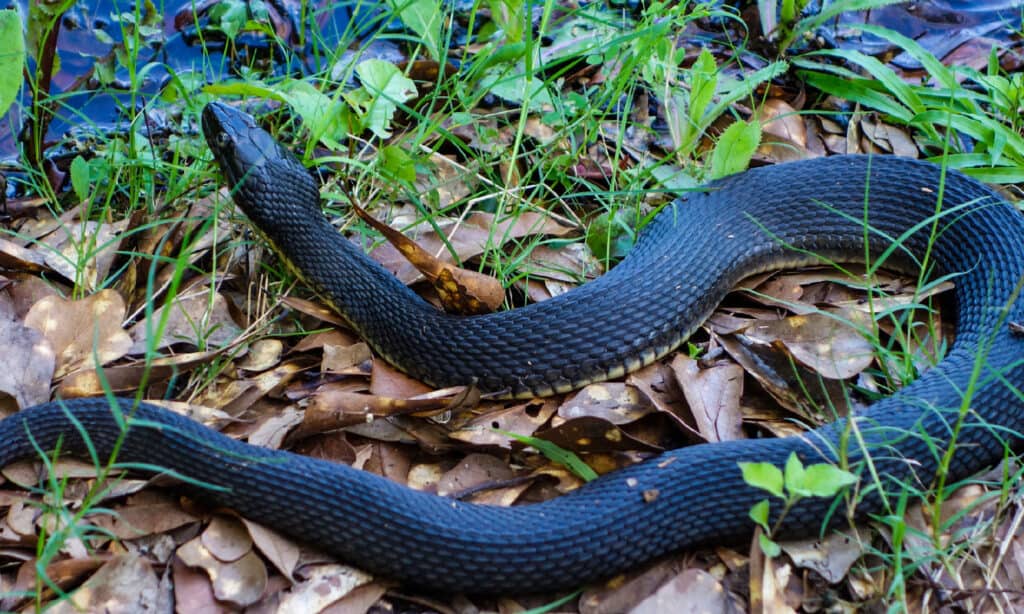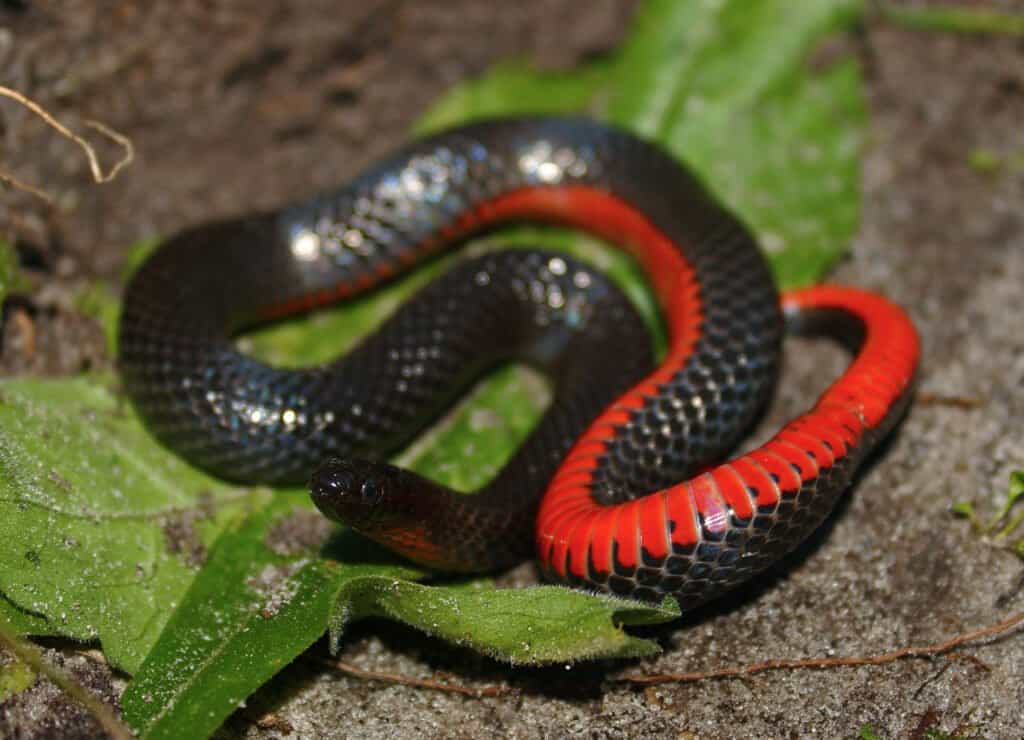Have you recently found a black water snake if your pool? Or maybe you were walking near a lake and saw something slithering out of the water. Regardless of the reason, you’re curious about these unique water snakes. Black water snakes can be frightening to look at. They are massive and quick swimmers.
Technically though, black water snakes aren’t a species. Instead, some water snakes are black or darker. But how can you tell them apart from other snakes? Are black water snakes dangerous? Where do they live? Follow along to learn more about some of the more black water snakes.

While technically black water snakes aren’t a species, some water snakes are black or darker.
©iStock.com/Alex Pankratov
Common Water Snakes
Common water snakes are nonvenomous snakes frequently mistaken for venomous cottonmouths. These snakes have many nicknames, including banded water snake, black water adder, North American water snake, spotted water snake, water pilot, and streaked snake. Common water snakes reach up to 4 feet and 5 inches long. However, the average female common water snake is about 2 feet and 8 inches. Female common water snakes are larger than male water snakes.
Common water snakes vary in color. Some are red, while others are brown-grey, or black. These water snakes have unique dark blotches on their bodies and cross bands on their necks. Common water snakes are abundant in North America. They are especially common throughout eastern and central North America starting from Ontario and ending in Texas and Florida in the south. There are four common water snake subspecies, one of which is an invasive species in California. While common water snakes aren’t venomous, their bites still hurt. When threatened or picked up, they bite repeatedly and release musk.

Common water snakes are nonvenomous snakes frequently mistaken for venomous cottonmouths.
©Jay Ondreicka/Shutterstock.com
Southern Water Snakes
While it’s scary to spot a southern water snake near you, they are nonvenomous mostly aquatic snakes. You can find them throughout the Midwest and the Southeastern United States. Some states you can find southern water snakes are Louisiana, Indiana, and Florida. Southern water snakes are invasive snakes in California. Some have also been found as far as the Colorado River basin near Yuma, Arizona. Southern water snakes are long, growing between 24 to 42 inches long. The largest recorded size of a southern water snake is 62.5 inches long. While southern water snakes can be grey-green, brown, and gray, their coloration is so dark, they appear black. In fact, most southern water snakes are so dark, their cross bands are barely visible. Like other water snake species, females are larger than males.
Southern water snakes have big appetites. They mainly consume fish and frogs. However, larger southern water snakes sometimes hunt for small turtles, birds, and crayfish. Southern water snakes also give birth to live young. Interestingly, while uncommon, southern water snakes and common water snakes can hybridize.

Southern water snakes are nonvenomous, mostly aquatic snakes that are so dark they appear black.
©EdwinWilke/Shutterstock.com
Black Swamp Snakes
Black swamp snakes are rare and unique. They are native to the southeastern United States. There are also three black swamp snake species, the South Florida swamp snake, the Carolina swamp snake, and the North Florida swamp snake. Black swamp snakes are also called mud snakes and red-bellied mud snakes. These snakes mainly live on swampy land with lots of vegetation. Black swamp snakes spend most of their time in the water hiding under vegetation in tannic cypress swamps. Adult black swamp snakes hunt for small fish, tadpoles, frogs, leeches, and salamanders. Unlike other water snake species, black swamp snakes are small. They are nonvenomous and grow between 10 to 15 inches long, however, experts have recorded 18-inch-long black swamp snakes previously. Black swamp snakes give birth to their young live and newborns are typically less than 5 inches long. As their name suggests, black swamp snakes have black shiny backs and black bars or triangles that lead to bright red-orange bellies.

Black swamp snakes have black shiny backs and red-orange bellies and spend most of their time in the water hiding under vegetation.
©Peter Paplanus / flickr – License
What To Do If You’re Bitten By a Black Water Snake
Although it’s not always possible to avoid a snake bite, prevention is key. Since most water snakes live in shallow and murky water, you might want to avoid swimming in these waters. If you think you’ve been bitten by a black water snake, move away from the area. Don’t immediately look for the snake, it’s likely long gone. Instead, wash the bite and area with water and soap. It’s unlikely that the black water snake is venomous. However, if you start feeling weak or have symptoms of a venomous snakebite, call your local emergency number. For example, if the skin around the bite changes color, this is a sign the snake could have been venomous. Thankfully, only about 20% of snakes in the United States are venomous. Most snakebites cause swelling and burning pain for the first 15 to 30 minutes. It’s also important you never put ice directly on a snakebite or drink caffeine. This increases the speed of your body’s absorption of venom.
The photo featured at the top of this post is © iStock.com/passion4nature
Discover the "Monster" Snake 5X Bigger than an Anaconda
Every day A-Z Animals sends out some of the most incredible facts in the world from our free newsletter. Want to discover the 10 most beautiful snakes in the world, a "snake island" where you're never more than 3 feet from danger, or a "monster" snake 5X larger than an anaconda? Then sign up right now and you'll start receiving our daily newsletter absolutely free.
Thank you for reading! Have some feedback for us? Contact the AZ Animals editorial team.






